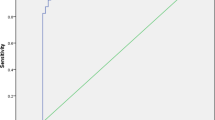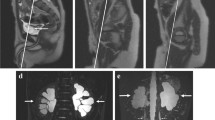Abstract
Background. Gadolinium-enhanced MRI has recently been employed in the diagnosis of acute pyelonephritis. Its potential utility in the diagnosis of renal scars in children is unknown. Objective. To evaluate the potential utility of MRI using fat-saturated T1-weighted (T1-W) and post-gadolinium, short-tau inversion-recovery (STIR) sequences in detecting renal scarring by comparison with technetium dimercaptosuccinic acid (99 mTc-DMSA) renal scintigraphy in children at risk of renal scarring. Materials and methods. A group of 24 children with spina bifida and neurogenic bladder or anorectal anomaly was studied. No patient had a history of acute pyelonephritis. Documented urinary tract infection (UTI) was present in 10 children (42 %). The remaining 14 (58 %) children had a history of asymptomatic bacteriuria. None had clinical signs or symptoms of acute UTI at the time of the study. 99 mTc-DMSA and MRI were performed to detect renal scarring. 99 mTc-DMSA scans were supplemented with pinhole imaging. MRI of the kidneys employed a fat-saturated T1-W sequence and a post-gadolinium STIR sequence employing a short echo time. Results. Of the kidneys studied, 33 % (n = 16) had evidence of a renal parenchymal defect suggestive of scarring on 99 mTc-DMSA. The concordance in the detection of a scarred kidney by post-gadolinium STIR sequence and 99 mTc-DMSA is 94 %; that by fat-saturated T1-W sequence and 99 mTc-DMSA is 82 %; that by both sequences (positive result on either sequence) and 99 mTc-DMSA is 100 %. Using 99 mTc-DMSA as the gold standard, MRI had a sensitivity of 100 % and a specificity of 78 % in the diagnosis of a scarred kidney. The concordance in the detection of a scarred zone by post-gadolinium STIR sequence and 99 mTc-DMSA is 68 %; that by fat-saturated T1-W sequence and DMSA is 44 %; that by both sequences (positive result on either sequence) and 99 mTc-DMSA is 84 %. MRI had a sensitivity of 84 % and a specificity of 86 % in the diagnosis of a scarred zone, using 99 mTc-DMSA as the gold standard. Conclusion. The detection rate for renal scarring on MRI using the fat-saturated T1-W and post-gadolinium STIR sequences is comparable to planar 99 mTc-DMSA. MRI is of potential utility in the evaluation of children at risk of renal scarring.
Similar content being viewed by others
Author information
Authors and Affiliations
Additional information
Received: 9 September 1998 Accepted: 10 May 1999
Rights and permissions
About this article
Cite this article
Chan, YL., Chan, KW., Yeung, CK. et al. Potential utility of MRI in the evaluation of children at risk of renal scarring. Pediatric Radiology 29, 856–862 (1999). https://doi.org/10.1007/s002470050713
Issue Date:
DOI: https://doi.org/10.1007/s002470050713




